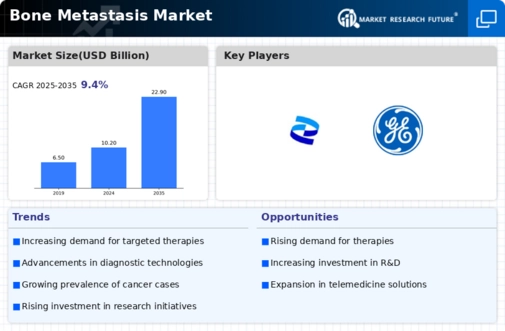-
Report Prologue
-
Chapter 2. Market Introduction
-
2.1
-
Definition
-
Scope of the Study
- Research
- Assumptions
- Limitations
-
Objective
-
Chapter
-
Research Methodology
-
Introduction
-
Primary
-
Research
-
Secondary research
-
Market
-
Size Estimation
-
Chapter
-
Market Dynamics
-
Drivers
-
Restraints
-
Opportunities
-
4.4
-
Challenges
-
4.5
-
Macroeconomic Indicators
-
Technology Trends & Assessment
-
Chapter 5. Market Factor Analysis
-
Porter’s
- Bargaining Power of Buyers
- Threat
- Threat of Substitutes
-
Five Forces Analysis
-
5.1.1
-
Bargaining Power of Suppliers
-
of New Entrants
-
5.1.5
-
Intensity of Rivalry
-
Value Chain Analysis
-
Investment
-
Feasibility Analysis
-
Pricing Analysis
-
Chapter 6. Global
-
Bone Metastasis Market, by Type
-
Introduction
-
Osteolytic
-
Bone Metastasis
-
Market
-
Estimates & Forecast, 2020–2027
-
Osteoblastic Bone Metastasis
-
Market Estimates &
-
Forecast, 2020–2027
-
Mixed Bone Metastasis
-
Market Estimates & Forecast, 2020–2027
-
Others
-
Chapter 7.
-
Global Bone Metastasis Market, by Diagnosis
-
Introduction
-
Biopsy
-
Market Estimates &
-
Forecast, 2020–2027
-
Blood Test
-
Market Estimates & Forecast, 2020–2027
-
Imaging
- X-ray
- Bone Scintigraphy
- Computerized
- Positron Emission Tomography
- Others
-
Market Estimates &
-
Forecast, 2020–2027
-
Tomography
-
7.4.4
-
Magnetic Resonance Imaging
-
Others
-
Chapter 8.
-
Global Bone Metastasis Market, by Treatment
-
Introduction
-
Medical
- Chemotherapy
- Targeted
- Others
-
Therapies
-
Market
-
Estimates & Forecast, 2020–2027
-
therapy
-
8.2.3
-
Hormone therapy
-
8.2.4
-
Ablation Therapy
-
Market
-
Estimates & Forecast, 2020–2027
-
Ablation
-
8.2.4.2
-
Cryoablation
-
Surgery
- Vertebroplasty
- Kyphoplasty
-
Market Estimates &
-
Forecast, 2020–2027
-
Medication
- Pain Medications
- Bone-Building
-
Market Estimates &
-
Forecast, 2020–2027
-
Market Estimates & Forecast, 2020–2027
-
8.4.1.1
-
Ibuprofen
-
8.4.1.2
-
Morphine
-
Medications
-
Market
-
Estimates & Forecast, 2020–2027
-
8.4.2.2
-
Bisphosphonates
-
Market
-
Estimates & Forecast, 2020–2027
-
8.4.2.2.2
-
Pamidronate
-
8.4.2.2.3
-
Medronate
-
Others
-
Chapter 9.
-
Global Bone Metastasis Market, by End-User
-
Introduction
-
Hospital
-
& Clinics
-
Market
-
Estimates & Forecast, 2020–2027
-
Diagnostic Centers
-
Market Estimates &
-
Forecast, 2020–2027
-
Pharmacies
-
Market Estimates & Forecast, 2020–2027
-
Ambulatory
-
Surgical Centers
-
Market
-
Estimates & Forecast, 2020–2027
-
Others
-
Chapter 10. Global Bone Metastasis
-
Market, by Region
-
10.1
-
Introduction
-
10.2
-
America
-
10.2.1
-
North America
-
10.2.1.1
-
U.S.
-
10.2.1.2
-
Canada
-
10.2.2
-
South America
-
10.3
-
Europe
-
10.3.1
-
Western Europe
-
10.3.1.1
-
Germany
-
10.3.1.2
-
France
-
10.3.1.3
-
Italy
-
10.3.1.4
-
Spain
-
10.3.1.5
-
U.K.
-
10.3.1.6
-
Rest of Western Europe
-
of Korea
-
10.4.6
-
Rest of Asia Pacific
-
Arab Emirates
-
10.5.2
-
Saudi Arabia
-
10.5.3
-
Oman
-
10.5.4
-
Kuwait
-
10.5.5
-
Qatar
-
10.5.6
-
Rest of the Middle East & Africa
-
Chapter 11. Company Landscape
-
11.1
-
Introduction
-
11.3
-
Key Development & Strategies
-
Chapter
-
Eastern Europe
-
Asia Pacific
- Japan
- China
- India
- Australia
- Republic
-
The Middle East & Africa
- United
-
Market Share Analysis
- Key Developments
-
Company Profiles
-
F. Hoffmann-La Roche Ltd
- Company
- Type Overview
- Financials
- Key
- SWOT Analysis
-
Overview
-
Developments
-
Bayer
- Type Overview
- Key Developments
-
AG
-
12.2.1
-
Company Overview
-
12.2.3
-
Financial Overview
-
12.2.5
-
SWOT Analysis
-
Merck & Co., Inc.
- Company
- Type Overview
- Financial
- SWOT Analysis
-
Overview
-
Overview
-
12.3.4
-
Key Development
-
Pfizer
- Type/Business Segment Overview
- Key Development
-
Inc.
-
12.4.1
-
Company Overview
-
12.4.3
-
Financial Overview
-
12.4.5
-
SWOT Analysis
-
Novartis AG
- Company
- Type Overview
- Financial
- Key Developments
- SWOT
-
Overview
-
overview
-
Analysis
-
Pharmalucence Inc.
- Company Overview
- Financial Overview
- SWOT Analysis
- Overview
- Type
- Financials
- Key
- SWOT Analysis
- Type Overview
- Financials
- SWOT Analysis
- Type Overview
- Financials
- SWOT Analysis
- Overview
- Type
- Financials
- Key
- SWOT Analysis
-
12.6.2
-
Type Overview
-
12.6.4
-
Key Developments
-
12.7
-
Koninklijke Philips N.V.
-
Overview
-
Developments
-
12.8
-
GENERAL ELECTRIC
-
12.8.1
-
Overview
-
12.8.4
-
Key Developments
-
12.9
-
Siemens AG
-
12.9.1
-
Overview
-
12.9.4
-
Key Developments
-
12.10
-
TOSHIBA CORPORATION
-
Overview
-
Developments
-
Others
-
Chapter 13
-
MRFR Conclusion
-
Key Findings
- From
- Unmet Needs of the Market
-
CEO’s View Point
-
13.2
-
Key Companies to Watch
-
Prediction of Bone Metastasis
-
Market
-
Chapter
-
Appendix
-
LIST OF TABLES
-
Bone Metastasis Industry
-
Synopsis, 2020–2027
-
Global Bone Metastasis
-
Market Estimates & Forecast, 2020–2027, (USD Million)
-
Table 3
-
Global Bone Metastasis Market, by Region, 2020–2027, (USD Million)
-
Table 4
-
Global Bone Metastasis Market, by Type, 2020–2027, (USD Million)
-
Table 5
-
Global Bone Metastasis Market, by Diagnosis, 2020–2027, (USD Million)
-
Table 6
-
Global Bone Metastasis Market, by Treatment, 2020–2027, (USD Million)
-
Table 7
-
Global Bone Metastasis Market, by End-User, 2020–2027, (USD Million
-
Table 8
-
North America Bone Metastasis Market, by Type, 2020–2027, (USD Million)
-
Table 9
-
North America Bone Metastasis Market, by Diagnosis, 2020–2027, (USD
-
Million)
-
Table
-
North America Bone Metastasis Market, by Treatment, 2020–2027,
-
(USD Million)
-
Table
-
North America Bone Metastasis Market, by End-User, 2020–2027,
-
(USD Million)
-
Table
-
U.S. Bone Metastasis Market, by Type, 2020–2027, (USD
-
Million)
-
Table
-
U.S. Bone Metastasis Market, by Diagnosis, 2020–2027,
-
(USD Million)
-
Table
-
U.S. Bone Metastasis Market, by Treatment, 2020–2027,
-
(USD Million)
-
Table
-
U.S. Bone Metastasis Market, by End-User, 2020–2027,
-
(USD Million)
-
Table
-
Canada Bone Metastasis Market, by Type, 2020–2027, (USD
-
Million)
-
Table
-
Canada Bone Metastasis Market, by Diagnosis, 2020–2027,
-
(USD Million)
-
Table
-
Canada Bone Metastasis Market, by Treatment, 2020–2027,
-
(USD Million)
-
Table
-
Canada Bone Metastasis Market, by End-User, 2020–2027,
-
(USD Million)
-
Table
-
South America Bone Metastasis Market, by Type, 2020–2027,
-
(USD Million)
-
Table
-
South America Bone Metastasis Market, by Diagnosis, 2020–2027,
-
(USD Million)
-
Table
-
South America Bone Metastasis Market, by Treatment, 2020–2027,
-
(USD Million)
-
Table
-
South America Bone Metastasis Market, by End-User, 2020–2027,
-
(USD Million)
-
Table
-
Europe Bone Metastasis Market, by Type, 2020–2027, (USD
-
Million)
-
Table
-
Europe Bone Metastasis Market, by Diagnosis, 2020–2027,
-
(USD Million)
-
Table
-
Europe Bone Metastasis Market, by Treatment, 2020–2027,
-
(USD Million)
-
Table
-
Europe Bone Metastasis Market, by End-User, 2020–2027,
-
(USD Million)
-
Table
-
Western Europe Bone Metastasis Market, by Type, 2020–2027,
-
(USD Million)
-
Table
-
Western Europe Bone Metastasis Market, by Diagnosis, 2020–2027,
-
(USD Million)
-
Table
-
Western Europe Bone Metastasis Market, by Treatment, 2020–2027,
-
(USD Million)
-
Table
-
Western Europe Bone Metastasis Market, by End-User, 2020–2027,
-
(USD Million)
-
Table
-
Eastern Europe Bone Metastasis Market, by Type, 2020–2027,
-
(USD Million)
-
Table
-
Eastern Europe Bone Metastasis Market, by Diagnosis, 2020–2027,
-
(USD Million)
-
Table
-
Eastern Europe Bone Metastasis Market, by Treatment, 2020–2027,
-
(USD Million)
-
Table
-
Eastern Europe Bone Metastasis Market, by End-User, 2020–2027,
-
(USD Million)
-
Table
-
Asia Pacific Bone Metastasis Market, by Type, 2020–2027,
-
(USD Million)
-
Table
-
Asia Pacific Bone Metastasis Market, by Diagnosis, 2020–2027,
-
(USD Million)
-
Table
-
Asia Pacific Bone Metastasis Market, by Treatment, 2020–2027,
-
(USD Million)
-
Table
-
Asia Pacific Bone Metastasis Market, by End-User, 2020–2027,
-
(USD Million)
-
Table
-
The Middle East & Africa Bone Metastasis Market, by Type,
-
The Middle East & Africa Bone Metastasis
-
Market, by Diagnosis, 2020–2027, (USD Million)
-
The Middle East &
-
Africa Bone Metastasis Market, by Treatment, 2020–2027, (USD Million)
-
Table 43
-
The Middle East & Africa Bone Metastasis Market, by End-User, 2020–2027,
-
(USD Million)
-
LIST
-
OF FIGURES
-
Figure
-
Research Process
-
Segmentation for Global Bone
-
Metastasis Market
-
Market Dynamics for Global Bone Metastasis
-
Market
-
Figure
-
Global Bone Metastasis Market Share, by Type 2020
-
Figure 5
-
Global Bone Metastasis Market Share, by Diagnosis 2020
-
Global Bone Metastasis
-
Market Share, by Treatment, 2020
-
Global Bone Metastasis Market Share, by
-
End-User, 2020
-
Figure
-
Global Bone Metastasis Market Share, by Region, 2020
-
Figure 9
-
North America Bone Metastasis Market Share, by Country, 2020
-
Europe
-
Bone Metastasis Market Share, by Country, 2020
-
Asia Pacific Bone Metastasis
-
Market Share, by Country, 2020
-
The Middle East & Africa Bone Metastasis
-
Market Share, by Country, 2020
-
Global Bone Metastasis Market: Company
-
Share Analysis, 2020 (%)
-
F. Hoffmann-La Roche Ltd: Key Financials
-
Figure 15
-
F. Hoffmann-La Roche Ltd: Segmental Revenue
-
F. Hoffmann-La Roche
-
Ltd: Geographical Revenue
-
Bayer AG: Key Financials
-
Bayer
-
AG: Segmental Revenue
-
Figure
-
Bayer AG: Geographical Revenue
-
Merck & Co., Inc.:
-
Key Financials
-
Figure
-
Merck & Co., Inc.: Segmental Revenue
-
Merck
-
& Co., Inc.: Geographical Revenue
-
Pfizer Inc.: Key Financials
-
Figure 24
-
Pfizer Inc.: Segmental Revenue
-
Pfizer Inc.: Geographical Revenue
-
Figure 26
-
Novartis AG: Key Financials
-
Novartis AG: Segmental Revenue
-
Figure 28
-
Novartis AG: Geographical Revenue
-
Pharmalucence Inc.: Key Financials
-
Figure 30
-
Pharmalucence Inc.: Segmental Revenue
-
Pharmalucence Inc.: Geographical
-
Revenue
-
Figure
-
Koninklijke Philips N.V.: Key Financials
-
Koninklijke
-
Philips N.V.: Segmental Revenue
-
Koninklijke Philips N.V.: Geographical
-
Revenue
-
Figure
-
GENERAL ELECTRIC: Key Financials
-
GENERAL ELECTRIC: Segmental
-
Revenue
-
Figure
-
GENERAL ELECTRIC: Geographical Revenue
-
Siemens AG: Key Financials
-
Figure 39
-
Siemens AG: Segmental Revenue
-
Siemens AG: Geographical Revenue
-
Figure 41
-
TOSHIBA CORPORATION: Key Financials
-
TOSHIBA CORPORATION:
-
Segmental Revenue
-
Figure
-
TOSHIBA CORPORATION: Geographical Revenue





Leave a Comment